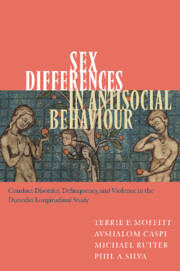 Sex Differences in Antisocial Behaviour
Sex Differences in Antisocial Behaviour Published online by Cambridge University Press: 22 September 2009
In this chapter, we compare the sexes on disorders and psychiatric conditions that co-occur with antisocial disorders during the developmental period from ages 11 to 21. We examine mental retardation, reading retardation, attention deficit-hyperactivity disorder (ADHD), anxiety disorders, depression and dysthymia, mania, eating disorders, alcohol and marijuana dependence, and schizophreniform symptoms. The chapter addresses three issues. How common is comorbidity among young people who have conduct disorder? What is the pattern of cumulative co-occurrence of conduct disorder with other disorders across the period of the life span we study, and does this pattern differ for males and females? Are there changing patterns of comorbidity with conduct problems across the repeated assessments of the study, and do those patterns differ for males and females?
In recent years awareness has increased about the phenomenon of comorbidity, the concurrent diagnosis of two or more mental disorders within the same individual. Epidemiological studies show that approximately half of all persons with a mental disorder have more than one diagnosable disorder (Clark, Watson, and Reynolds, 1995). The ubiquity of comorbidity has implications for research methodology, clinical practice, and diagnostic nosologies (Caron and Rutter, 1991; Angold, Costello and Erkanli, 1999). With respect to research methodology, it has been shown that comorbidity can confound developmental studies of the onset and course of a disorder (Sher and Trull, 1996).
To save this book to your Kindle, first ensure no-reply@cambridge.org is added to your Approved Personal Document E-mail List under your Personal Document Settings on the Manage Your Content and Devices page of your Amazon account. Then enter the ‘name’ part of your Kindle email address below. Find out more about saving to your Kindle.
Note you can select to save to either the @free.kindle.com or @kindle.com variations. ‘@free.kindle.com’ emails are free but can only be saved to your device when it is connected to wi-fi. ‘@kindle.com’ emails can be delivered even when you are not connected to wi-fi, but note that service fees apply.
Find out more about the Kindle Personal Document Service.
To save content items to your account, please confirm that you agree to abide by our usage policies. If this is the first time you use this feature, you will be asked to authorise Cambridge Core to connect with your account. Find out more about saving content to Dropbox.
To save content items to your account, please confirm that you agree to abide by our usage policies. If this is the first time you use this feature, you will be asked to authorise Cambridge Core to connect with your account. Find out more about saving content to Google Drive.